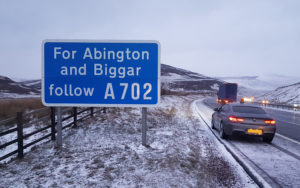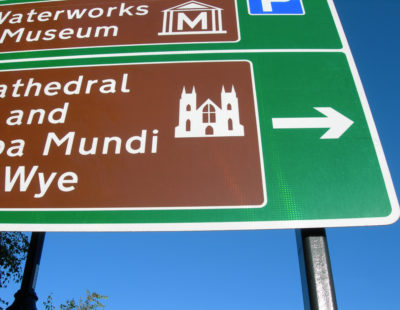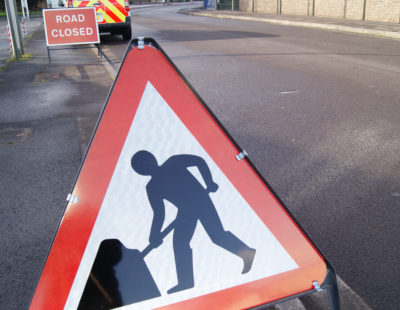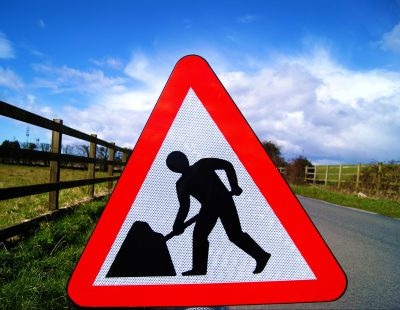When it comes to purchasing or manufacturing traffic signs, contractors, local authorities, or business owners may not know what they are looking for. There is plenty of choice in regard to traffic signs; size, shape, material, reflectivity and more can vary. All these aspects play an important role in keeping road users safe, whether that’s through directing traffic, warning of hazards, or protecting workers at street works. The reflectivity, in particular, ensures road users see important information during dark hours and plays a critical role in both compliance and lifesaving.
In this guide we explain all there is to know about reflective sheeting for traffic signs, giving buyers and beginners the low-down on their purchases. For advice on size, shape and use, check out the Traffic Signs Manual, guidance from the Department of Transport on The Traffic Signs Regulations and General Directions 2016 legislation.
For advice on reflective materials for vehicles, read our dedicated vehicle reflectives buyers guide.
What is reflective sheeting for traffic signs?
Traffic signs are normally made from aluminium, which is then covered with retroreflective sheeting. This sheeting makes the signs especially visible (or ‘conspicuous’) during dark hours. By being reflective and effectively reflecting car headlamp lights, traffic signs do not always need to be lit, reducing infrastructure and cost requirements, as well as making them portable if required.
Reflective sheeting, verses regular non-reflective sheeting, increases the visibility of signs at all times, saving more lives. The benefit of compliant, high-performing reflective sheeting for traffic signs cannot be overrated.
Our traffic and safety reflective products >
Regulations for traffic sign reflective sheeting
The particular legislation for reflective sheeting can depend on the traffic sign type, but there is plenty of guidance provided within the aforementioned Traffic Signs Manual. Permanent traffic signage has the related standard BS EN 12899 for “Fixed, vertical road traffic signs”. BS 8442:2015 applies to miscellaneous road traffic signs and devices, including temporary signs.
Permanent traffic signs regulations >
Temporary traffic signs regulations >
Key guidance from the Traffic Signs Manual relating to reflective sheeting includes:
11.2.2. Regulation 8 introduces the default requirement for upright signs to be illuminated throughout the hours of darkness by internal or external lighting or be reflectorised. This applies to all traffic signs unless other requirements are specified elsewhere in the Schedules.
11.3.5. Neither the method nor the level of sign lighting is regulated. The same is true of reflectorisation. However, the UK National Annex to BS EN 12899-1 specifies different performance classes for each characteristic of traffic signs for UK practice; as well as specifying requirements in respect of light sources, lighting units and electrical equipment.
There is additional legislation for traffic signs at street and road works, outlined in Safety at Street Works & Chapter 8, a code of practice for highway authorities and companies to keep workers and road users safe. Find out more with our blog on Safety at Street Works.
Types of reflective sheeting for traffic signs
As the name suggests, reflective sheeting for signs reflects light from headlamps to illuminate traffic signs for road users.
Retroreflective glass bead sheeting
Retroreflective sheeting is different to reflective sheeting. Where reflective sheeting reflects light like a mirror in various directions, glass bead retroreflective sheeting is made of thousands of tiny glass beads that direct light back to the original source. This sheeting is generally suitable for unlit roads, as headlamps illuminate these and make them visible, but it isn’t always suited to roads with streetlights or a large amount of light as the reflection may not be enough to make the sign conspicuous against the background.
Micro prismatic sheeting
Some micro prismatic materials offer higher levels of luminance and may be better suited to situations in which the luminance of signs may be compromised. These materials are manufactured by embossing thousands of micro-prisms into a face film, usually acrylic or polycarbonate. However, in some cases, micro prismatic materials may be too bright, i.e. in a dark country lane, and inhibit visibility. In these situations, often a glass bead or low grade micro-prismatic material are acceptable.
Air gap VS metallised micro prismatic products – a guide to reflective material construction >
View the list of available reflective sheeting materials, including their grade and suitable application here. The higher the grade, the higher the reflectivity and therefore visibility, even in ambient lighting conditions. There are three grades to be aware of: engineering grade, high intensity and prismatic grade.
See our reflective film matrix for more information.
Traffic sign reflective sheeting considerations
Colour retroreflection
All parts of a traffic sign face must be reflective unless coloured black – partial coverage is unacceptable as highlighted in the below guidance from the Traffic Signs Manual. For traffic signs to be compliant, they must meet the correct standard of retroreflection and regulated colour for the application.
11.2.11. When signs are reflectorised, all parts of the sign face not coloured black must be reflectorised (regulation 8). Partial reflectorisation is unlawful, as is partial lighting. Special requirements apply to the carriageway edge warning signs to diagram 560 (S262) which must only be reflectorised.
Traffic sign legibility
Whatever the advice is for the type of traffic sign, legibility must always be considered. The readability of retroreflective signs during dark hours is key to their effectiveness. Factors to consider include how much headlamp light hits the sign, the angle of approach to sign, junction layouts, higher positioning of HGV driver and amount of ambient lighting. For example, motorway overhead signs may have varying illumination requirements to lower positioned signs on lower-speed highways.
Durability
As the Traffic Signs Manual points out, the performance of reflective sheeting may degrade overtime, and it is therefore important to review the performance and quality. To remain compliant, traffic signs must continue to perform at the stipulated level.
8.1.2. Over time, signs gradually become faded and their retroreflective properties diminish. This will reduce both conspicuity and legibility by day and by night. Signs also become less effective when they are dirty, damaged or displaced as a result of vehicle impact or vandalism. Damaged or dirty signs also discredit the traffic authority and lessen road users’ respect for the signs. A periodic inspection of signs should be made to ensure their early repair and/or replacement when necessary. After-dark inspections should be made of lit and reflectorised signs, or a retroreflectometer may be used to measure the latter
Printing
The way in which reflective materials are printed may affect quality and performance. Here at Lakeside Group we have a range of industry leading digital traffic sign printers, designed specifically for compliance with the latest regulations. The Avery Dennison TrafficJet Pro printer, designed for efficient productivity, and the TrafficJet Xpert, optimised for compliant traffic signage, ensure reflective sheeting for road signs of top quality and superior durability.
We also offer a range of TrafficJet service support packages for our Avery Dennison TrafficJet clients, ensuring cost-effective maintenance of their printer.
Get a quote for traffic sign reflective sheeting
At Lakeside, we specialise in reflective sheeting for traffic sign and vehicle applications. If you’re looking for unrivalled durability for your permanent traffic signage, check out the below video to find out more about our winning combination of 15 year R3C micro prismatic sheeting, durable TrafficJet inks and OL-1200 dew-resistant overlay film.
For more information on any of our products, get in touch with one of our friendly team!
See more: A buyer’s guide to reflective vinyl




